Friendly and affectionate with their bristling bushy beards, eyebrows, and great personalities to boot, this is the Parti Schnauzer.
Now I was fortunate to grow up with my parent’s Standard Schnauzer, Bruno, who became a loyal playmate for my sister and me.
Patient, yes, we used to dress him up, and even-tempered, he surpassed all our expectations and lived to the ripe age of 15.
Tough and muscular, these highly intelligent and lively dogs have a personality that is twice their size.
People-orientated and with a flair for mischief, you will be hard-pressed not to fall for these delightful dogs.
In this article, we look at this breed of dog and, in particular, the Parti Miniature Schnauzer, which has become one of America’s most popular dogs.
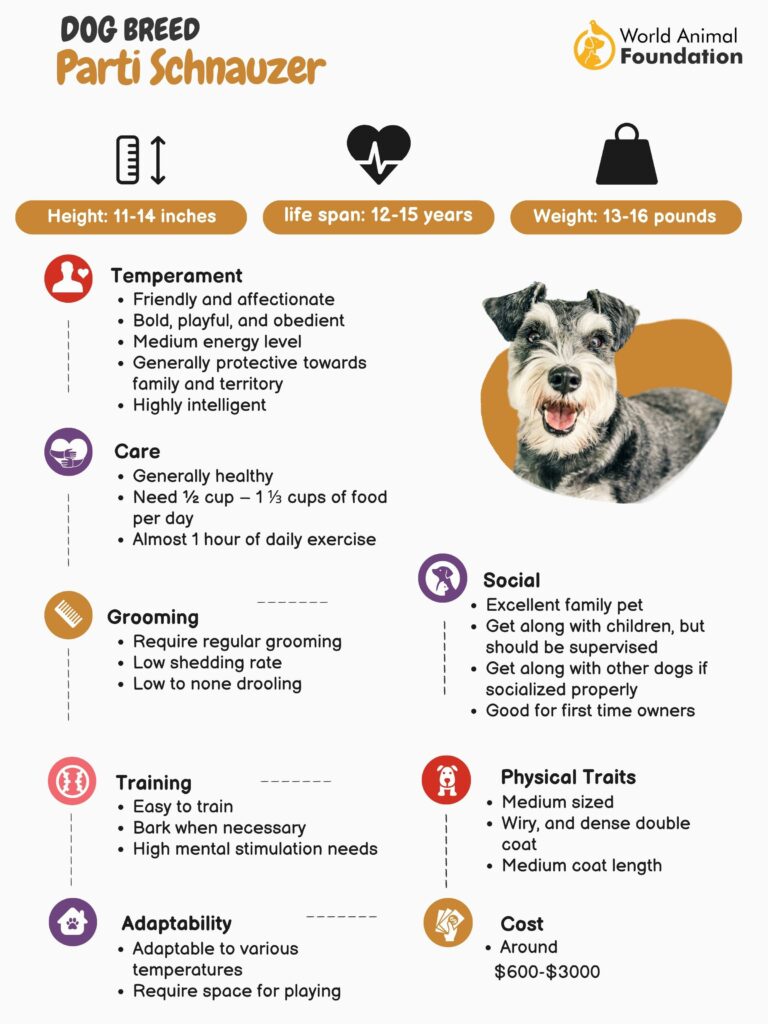
About the Breed
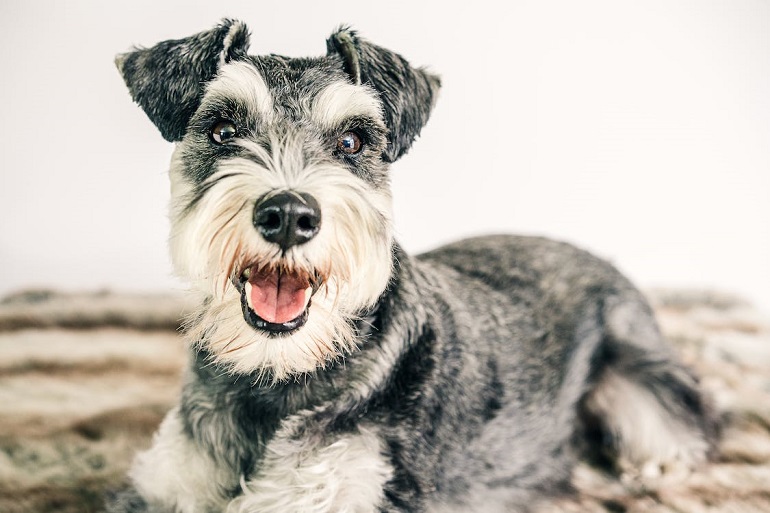
High-spirited, bold, loyal, and obedient with eyes gleaming with intelligence and an engaging personality, this is the stocky Parti Miniature Schnauzer.
But Parti Miniature Schnauzers are not a specific breed of dog as such. In essence, they are miniature schnauzers that present with a rare pigmentation pattern on their coats.
Unlike miniature schnauzers with their distinctive black, salt, and pepper and black and silver coat colors, a parti schnauzer has some of the predominant base color and even more intermingled with white patches.
In fact, it was from the standard schnauzer that the giant and miniature schnauzer breeds arose, with the parti pigmentation seen across all varieties.
Other dog breeds, such as the Great Dane and Affenpinscher and the standard schnauzer, all played a role in creating both the giant and the miniature schnauzer varieties we find today.
So, here’s what to look for if you are thinking of acquiring a parti schnauzer pup:
Parti Schnauzer Puppies
Cute and cuddly with that puppy dog smell, it’s too easy to get carried away and forget to ask some basic questions from the breeder about the Parti Schnauzer puppy.
First off, the Parti puppies should be seen interacting with the rest of the litter and its parents. It should act normal, be clean and confident, and appear healthy.
Next up, ask the breeder about health certificates, such as the Progressive Retinol Atrophy test, which should be carried out on the entire litter. Additionally, ask to see health clearances on both parents of the pup.
Ask the breeder about their references, as a reputable breeder will have these on hand from previous buyers and veterinarians.
Also, ask how many litters the dam has produced. Typically, it should only be once a year to let breeding dogs rest.
Additionally, ask the breeder about pre-existing genetic diseases in the puppy’s bloodline and any specific medical conditions to be aware of in miniature schnauzers.
Lastly, unlike irresponsible breeders or puppy mills, a reputable breeder will also present you with a puppy pack containing vaccination information, food requirements, worming medication, exercise, and information in general on what milestones to look out for.
Vital Stats
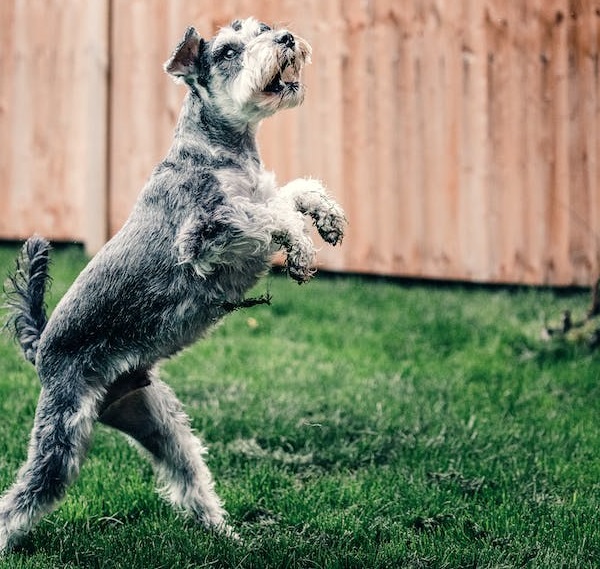
With their stocky little bodies, bushy beard, and eyebrows, here’s how the Parti Miniature Schnauzer stacks up to its larger cousin, the Standard Schnauzer.
- Breed Group: Terrier
- Height: 12 to 14 inches
- Weight: 11 to 20 pounds
- Lifespan: 12 to 15 years
History of Parti Schnauzer
With a rich lineage stretching as far back as the 15th century, the modern-day Parti Miniature Schnauzer is a product of German farmers who, at the time, bred the standard schnauzer down to miniature size to be barnyard ratters and farm dogs.
This was achieved by crossing standard schnauzers with rat terrier breeds such as the Affenpinscher, poodle Pomeranian, and miniature pincher, thereby creating the miniature schnauzer we know today.
And it was due to these crossings with other breeds with their parti-colored coats that helped contribute to the foundation of the white spotting genes found in the Parti Schnauzer’s coat.
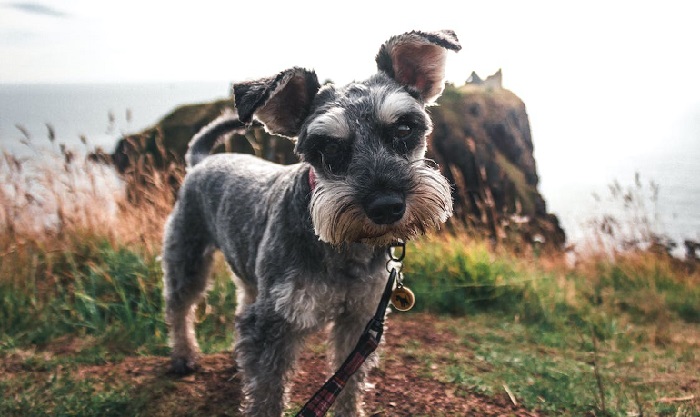
Being proudly a product of continental stock with no British terrier blood in their veins explains partly why these miniature schnauzers do not display many British isle terrier traits.
But Parti Schnauzers also have their own specific mention in the history books.
Back in 1880, the Pinscher-Schnauzer Klub of Germany published the breed standard for schnauzers, where the Parti Schnauzer with its distinctive coat markings was accepted.
In fact, Parti Schnauzers were bred for the first time at Abbagamba Kennel by Countess Kanitz, with the first parti schnauzer being registered with the Pinscher-Schnauzer Klub in 1929.
But all of that changed in 1933 when the club banned Parti Schnauzers and their breeding, with the parti pattern listed as penalized in their club breed standard.
What happened next is truly horrifying!
German breeders of Parti Schnauzers, on hearing the news and fearing penalization and penalties, got rid of their Parti Schnauzer in various ways, such as by stoning or drowning them.
But it was only due to Countess Kanitz, amongst others, who, on discovering the real reason behind the ban, managed to get the breeding rights and re-recognition of Parti Schnauzers by the club.
And the real reason behind the ban? It all came down to sales competition between Wire-haired fox terriers and the salt and pepper-colored schnauzers at the time.
Yet despite the club promising to recognize Parti Schnauzers as a distinct breed, it never occurred, thanks in part to the rise of the Third Reich and the onset of World War 2.
And sadly, even today, Parti Schnauzers are still disqualified from show rings and discriminated against all due to their coat color.
Facts About the Parti Schnauzer
Did you know that each dog’s parti pattern is unique and that no two parti schnauzers will display the same patterns?
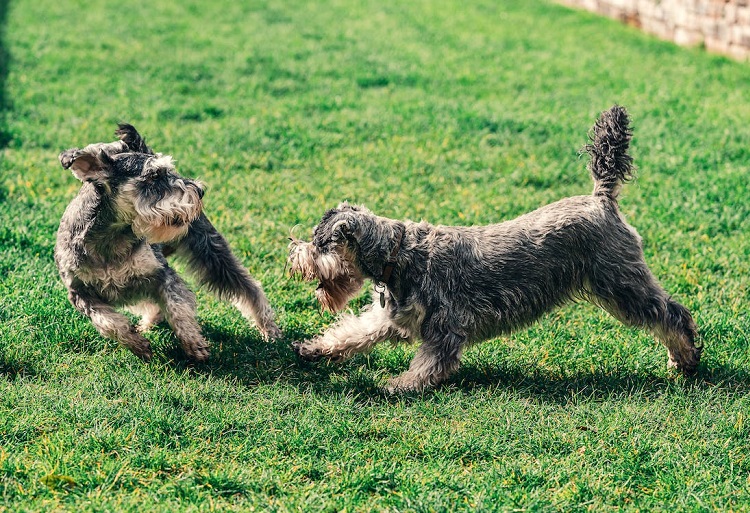
Here are some more interesting facts about these intelligent little dogs.
Purebreds
Even though they are recognized as purebreds, Parti Schnauzers, with their coat pattern, are not acceptable in show rings according to the American Kennel Club breed standards.
Pest Controllers
Parti Miniature Schnauzers, despite being companion dogs today, still make great pest controllers, having retained their instinctive prey drive to go after rodents.
Origin of the Word Schnauzer
The first recorded use of the word ‘Schnauzer’ was back in 1842, although the breed was developed in the 15th century. The name “Schnauzer” comes from the German word for snout and refers to the characteristic mustache of the schnauzer.
Parti Color Meaning
In dog world jargon, ‘parti’ or ‘parti-color’ literally means white patches.
These white patches are truly white due to the hair follicle in these areas making no pigment at all.
In fact, a dog who inherits one copy of the white spotting gene from either of its parents will have little to moderate white spotting.
While a dog that has inherited the white spotting gene from both parents will have larger white patches and, in some cases, can have so much white that they end up looking like white dogs with colored patches.
Traits and Characteristics of Parti Schnauzer
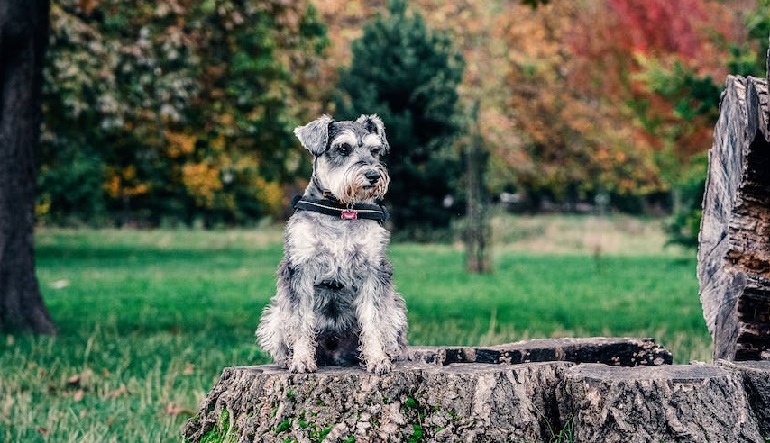
Just like their purebred solid-colored brethren, the Parti Miniature Schnauzer displays all the great attributes and characteristics that go into making an excellent family pet.
Smart and trainable, they are fearless, tough, and muscular without being aggressive and are apt to keep their owners amused with their playful antics.
Although friendly and affectionate, this schnauzer breed was bred to hunt small rodents first and foremost, a trait that still remains today, so they are prone to wanderlust if something catches their eye.
Alert and intelligent, they are very vocal and make great little watchdogs and loyal family companions.
But a word of caution, they are natural-born diggers and have a tendency to chew.
Physical Appearance
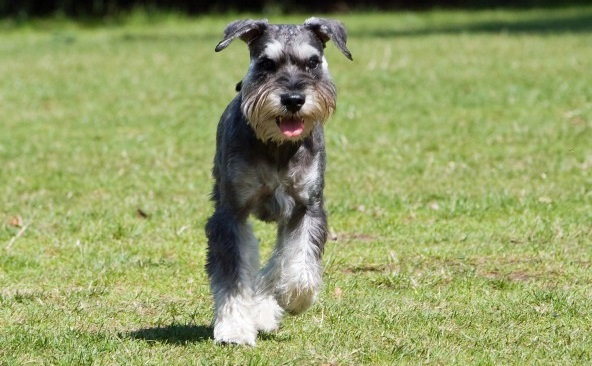
With their bushy beard and eyebrows, long head, rectangular-shaped muzzle, small almond-shaped eyes, and V-shaped, drop-down ears, the Parti Miniature Schnauzer makes for an adorable compact canine companion.
But there is so much more to this breed of schnauzer than its face with its human-like expression and stocky little body.
Size
The Parti Miniature Schnauzer is not as big as the standard schnauzer yet is bigger than the teacup schnauzer, which tips the scales at two to seven pounds and has a height of six to eight inches when fully grown.
Coat
Their fur has two layers: a soft undercoat and a wiry topcoat that doesn’t shed much. This makes them an ideal hypoallergenic dog for those that suffer from allergies.
Color
The color of the Parti Miniature Schnauzer is the most distinguishing feature of all.
Unlike miniature schnauzers with their coat colors of Black, Salt, and Pepper, and Black and Silver, the Parti Miniature Schnauzer presents with the following coloring interspersed with white patches:
This being black, liver and pepper, liver and tan, salt and pepper, and black and silver.
Markings
The coat marking of white patches over a base color is the stamp of a typical parti schnauzer.
And as such, this gives rise to their name. For instance, a solid black schnauzer with white markings is referred to as a Black Parti.
Parti Schnauzer Temperament and Personality
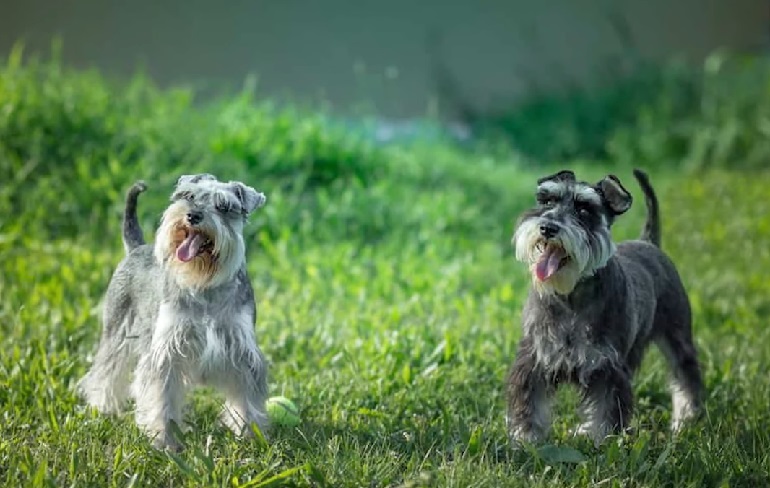
Parti Schnauzers are hard-wired working dogs, irrespective of whether they are giant, standard, or miniature schnauzers.
And as such, you can still expect them to display the traits they were initially bred to perform.
But unlike other terrier breeds in their class, such as the Scottish Terrier or Irish terrier, the Parti Miniature Schnauzer is not given dour independence or a fiery temperament.
In fact, they are spirited but obedient dogs who are overtly friendly and willing to please.
Tough and muscular, these little dogs are not known to be aggressive and generally get on with some animals and older children if properly socialized.
If anything, they are family orientated, enjoy vigorous play, and yet despite their small stature; they can put in a full day’s work patrolling for possible rodents.
Parti Schnauzer Health and Care
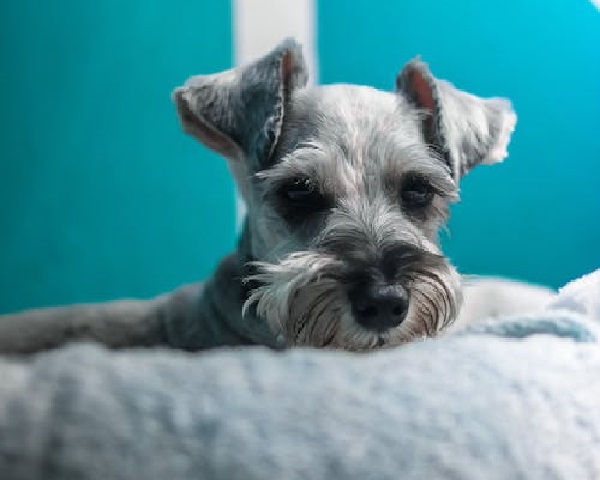
As with all other dog breeds, the Parti Miniature Schnauzer, although generally healthy, is prone to some health conditions.
Health
Besides being more susceptible to liver disease (hepatitis) than some other breeds, the Parti Miniature Schnauzer can also present with the following health conditions:
Hip Dysplasia
This is a deformity of the hip that occurs during the growth stage of a dog when both the head of the femur (the ball) and the socket in the pelvis grow at unequal rates.
This results in looseness of the joint, followed by osteoarthritis or degenerative joint disease.
Von Willebrand Disease
This bleeding disorder affects some purebred dogs and causes problems with how a dog’s blood clots.
The syndrome is genetic, meaning its inherited and puts dogs at risk for unusually heavy bleeding.
Pancreatitis
With pancreatitis, the digestive enzymes within the pancreas start attacking the organ, which results in mild or severe inflammation.
Miniature schnauzers are more prone to this condition, and supportive veterinary care and avoiding high fatty foods are advised.
Care
Despite having a wiry top coat and not shedding a lot, the Parti Miniature Schnauzer still requires frequent grooming as their top coat can become tangled and painful if left too long.
Brushing the Parti Miniature Schnauzers’ coat twice a week will suffice, although their wiry little beards and ears require more regular attention to prevent matting.
In fact, it is recommended that you bathe the miniature Schnauzer breed every four to six weeks, as overbathing can strip natural oils from their skin and coat.
Additionally, some schnauzers tend to tear up a lot, so a gentle wipe around the eyes is required before it stains their face.
Unfortunately, the miniature Schnauzer is prone to problems with their teeth. Regular brushing of the dog’s teeth to remove tartar will help prevent gum disease and tooth rot.
Parti Schnauzer Food And Diet
Despite their small and sturdy size, Parti Miniature Schnauzer is still moderately active, although they are one of the breeds most predisposed to weight gain.
And as such, they don’t require a lot to eat. In fact, it is recommended that an adult mini schnauzer only receives one cup of dry high-quality, dry dog food daily divided into two meals.
Food should be appropriate for the dog’s age, metabolism, and size and ideally contain a good mix of meat, vegetables, fruit, and grains without fillers.
Quick Facts about the Giant and Standard Parti Schnauzer
In addition to the Parti Miniature Schnauzer, there are two other members in the schnauzer family; the standard and giant.
Standard Schnauzer Breed
As mentioned previously, the standard Schnauzer was used as the building block from which to create both the giant and mini Parti Schnauzers.
Standing at 12 to 26 inches and weighing up to 70 pounds, the standard Schnauzer is classed as a medium-sized working dog with an expected lifespan of 12 to 15 years.
As such purebred standard schnauzers only come in two colors, black and salt, and pepper.
Interestingly enough, it was initially thought that this breed was bred from early European herding and guarding dog breeds.
Although later, it was suspected that they were mixed with the grey Wolfspitz and black poodle to create the distinctive salt and pepper Schnauzer coat color found on them today.
Bred to be guard dogs, ratters, and all-purpose dogs on German farms, the standard Schnauzer is still very protective of family and property today.
Giant Schnauzer Breed
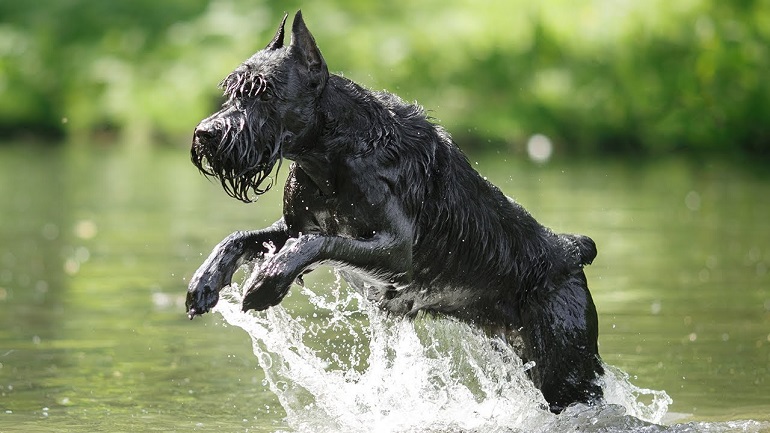
As the largest of the three breeds of Schnauzer, the Giant Schnauzer is an imposing dog standing at 27.5 inches and weighing up to 95 pounds.
Again the standard Schnauzer contributed to the bloodline as did the Great Dane, Bouvier des Flandres, and German Pinscher, although some suspect that German Shepherds, Rottweilers, and Dobermans, amongst others, all had a part to play in its breed.
Originally bred to assist on German farms with livestock herding and guarding, Giant schnauzers were eventually moved into cities to work as guard dogs.
In fact, these dogs were popular as military dogs during World War I and II.
Giant Schnauzers come in three color varieties being pure black, pepper and salt, and black and silver, and they have a lifespan of between 10 to 12 years.
Parti Schnauzer Training and Exercise
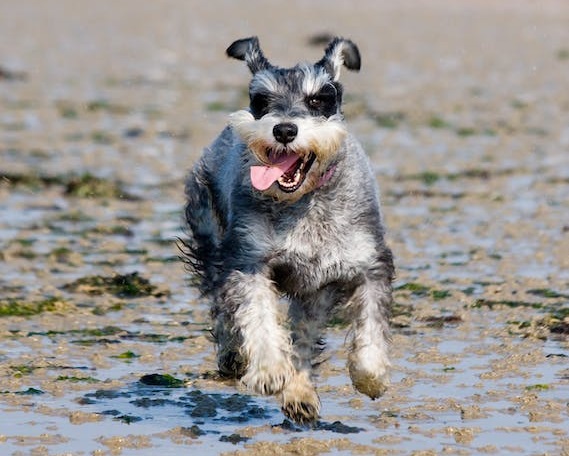
Despite their size, the miniature schnauzer is still an active dog with a medium energy level, and daily exercise is a must.
This could include a brisk walk or some backyard playtime.
But as mentioned previously, due to their high prey drive, these little warriors of the dog world are prone to bolt after smaller animals if something catches their eye.
As always, early socialization of a pup to new sounds, sights, other animals, and people is essential to ensure a well-rounded dog.
In fact, one of the great things about the Parti Schnauzer is that they are a quick study and always ready to please their owners, making them relatively easy to train.
But similarly, because of their intelligence, they can become bored if training is inconsistent and repetitive.
In fact, they can be strong-willed and have ‘selective hearing’ when it comes to obeying commands.
To stimulate them both mentally and physically and redirect their prey drive, look to obedience and agility training as well as rallies.
Parti Schnauzer Mixes
Over time, these free-spirited and well-tempered dogs have been bred with many other dog breeds to create some unusual, mixed-breed pooches.
Here are some of them.
- The Border Schnollie: A Schnauzer and Border Collie mix
- The Schnauzer Lab: A Schnauzer and Labrador retriever mix
- The German Schnauzer: A Schnauzer and German Shepherd mix
- The Miniboz: A Schnauzer and Boston terrier mix and
- The Eskimo Schnazer: A Schnauzer and American Eskimo mix
Pros and Cons of Owning a Parti Schnauzer
Just like all other dog breeds, Parti Colored Miniature Schnauzers come with both pros and cons.
Pros
- Friendly, intelligent, and easy to train
- Adaptable due to their size, they are small enough to adapt to apartment living but active enough to patrol farmland.
- They don’t shed much and are therefore considered hypoallergenic dogs
Cons
- Can have a tendency towards chewing and nip and play biting
- Prone to liver issues
- They require regular grooming
Relationship with Children
Parti Miniature Schnauzers, due to their even temperament and friendly, playful nature, are a popular choice for families with older children.
However, due to their tendency to nip and bite play, they may tend to snap back at young children or toddlers who antagonize them.
FAQ’s
What Are the Three Types of the Parti Colored Schnauzer?
There are three main members of the Schnauzer family: the Giant Schnauzer, the Standard Schnauzer, and the Miniature Schnauzer.
What Is the Rarest Color of This Breed?
Liver color and rusts. Although there are many variations of this coloring, generally, the darker the rust or orange color, the rarer it is and the more expensive.
Typically, the dog will present with brown pads and a brown nose with hazel, green, or brown eyes.
This coloring on the parti schnauzer is registered as Liver and Tan through the American Kennel Club.
Are Miniature Parti Schnauzers Okay with Being Left Alone?
These little dogs are out-and-out extroverts and love nothing more than attention. In fact, they are people driven and happiest in the heart of a busy and active household.
This means they don’t tolerate being left alone very well and can get up to mischief if alone for extended periods.
Conclusion
As with all other dog breeds, when considering acquiring a Parti Schnauzer or Miniature Schnauzer puppy, choose a reputable breeder or rehoming organization.
While Parti Miniature Schnauzers make great canine companions, they do require an owner that is prepared to meet all their physical and mental needs.
And as always, if possible andcircumstances allow for it, opt to adopt and don’t shop!


